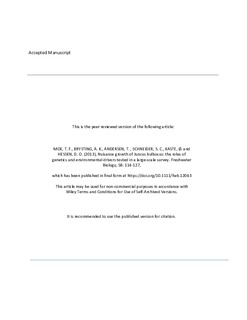| dc.description.abstract | 1. Invasive species can transform aquatic ecosystems, and the nuisance growth of the freshwater macrophyte Juncus bulbosus has become a problem in many lakes and rivers in northern Europe. It affects biodiversity strongly and conflicts with human uses, not least compromising the generation of hydroelectricity. The causes of the proliferation of these massive stands of J. bulbosus are not finally resolved, however.
2. In this study, a wide range of catchment, lake and sediment parameters (n = 34) were assessed for 139 lakes in Southern Norway, with the aim of explaining the presence or absence of J. bulbosus and to assess potential drivers behind its prolific growth.
3. Juncus bulbosus was more often present in lakes with lower pH and phosphate concentrations, and a higher element ratio of dissolved inorganic nitrogen (DIN) to total phosphorus (DIN : TotP).
4. Despite the many parameters measured across substantial environmental gradients, none explained nuisance growth. Genetic screening (amplified fragment length polymorphism fingerprinting) of plants from a subset of lakes and additional river sites also showed no genetic differences between the various growth forms. A macrophyte trophic index, however, suggested that the most problematic growth occurred in the most oligotrophic lakes.
5. The lack of consistent patterns may reflect either factors not assessed in our survey, or that the current extension of stands represents a gradual cumulative response over time, not characterised effectively in our snapshot survey. Nevertheless, we can now exclude some putative causes of nuisance growth, including in particular genetics and N‐deposition. | nb_NO |
